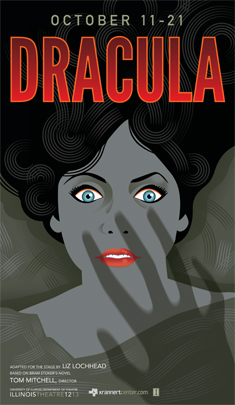 I have long been a fan of Bram Stoker’s Dracula, and I have, over the years, missed several opportunities to see various stage adaptations of the classic novel. So it was with no small amount of excitement that I waited in my plush seat for the performance at Krannert Center’s Colwell Playhouse to begin. Part of my expectation sprang from my love for the book on which the play is based. Stoker’s novel is a classic and has been the launching pad for countless imitations and iterations, and this has resulted in a culture positively obsessed with vampires — from the charming stalkers of the old Universal films, to the moody camp figures of Anne Rice and Joss Whedon, to the sparkly, sad-eyed Romeos of innumerable Twilight rip-offs. Personally, I have always been a sucker (no pun intended) for the old-school Bela Lugosi type.
I have long been a fan of Bram Stoker’s Dracula, and I have, over the years, missed several opportunities to see various stage adaptations of the classic novel. So it was with no small amount of excitement that I waited in my plush seat for the performance at Krannert Center’s Colwell Playhouse to begin. Part of my expectation sprang from my love for the book on which the play is based. Stoker’s novel is a classic and has been the launching pad for countless imitations and iterations, and this has resulted in a culture positively obsessed with vampires — from the charming stalkers of the old Universal films, to the moody camp figures of Anne Rice and Joss Whedon, to the sparkly, sad-eyed Romeos of innumerable Twilight rip-offs. Personally, I have always been a sucker (no pun intended) for the old-school Bela Lugosi type.
Another reason for me to be excited about the play is its director and cast. Tom Mitchell, the associate head of the theatre program at the U of I, is a talented director and a serious scholar of the art. His interpretations of the work of Tennessee Williams are well-known and always faithful and intriguing, so I wondered what he would bring to the staging of another famous piece of literature with Gothic themes and heavy undercurrents of passion and repression.
It must be noted that adapting a famous book for the stage cannot be easy. There have been several adaptations of Dracula over the years, and I’ve never read one that I liked. This script, by Liz Lochhead, was a new one to me, and I hoped for the best. The word “sanguine” occurs to me just now, since it means both “optimistic” and “bloody.” I was indeed sanguine about the show’s prospects, and I hoped against hope that Ms. Lochhead wouldn’t fall into the traps of exposition-heavy writing and shallow characterization as she tried to squeeze novel-sized plot and imagination into an evening’s entertainment.
As for the cast, many were actors I’ve seen over the years at Krannert and in other local venues. I was especially interested to see Christopher Terrell Brown and Ellen Fred, who play Jonathan Harker and Mina Westerman, respectively, and who would be sinking their teeth (again, no pun intended, this is just happening) into their biggest roles to date. And then, of course, there is J.W. Morrissette, who plays the titular Count himself. Morrissette’s credentials as an actor and an educator are impressive indeed, and I was eager to see his interpretation of Dracula the man … as well as Dracula the monster.
As the play began, I was charmed by the bareness of the stage. Aside from a couple of archways, very little scenery remains on stage for any length of time. Instead, many of the settings — including Mina Westerman’s home, the sanitarium of Dr. Seward, and Castle Dracula — are impressively implied using minimal furniture or props. Also impressive and effective are the sound design and, most especially, the lighting, which is heavy on shadows and manages to whisk the audience from place to place with little more than the occasional splash of color.
 One such color, an eerie yellow-green, is the favorite hue to illuminate the cell of Renfield, the madman who anticipates Dracula’s arrival and then falls victim to the powerful vampire’s capriciousness. The scenes within the sanitarium — and any others featuring the talented Brian Zielnicki, who plays Renfield as a mesmerizing combination of bogeyman and soothsayer, are some of the best and tightest in the play. Every time the lights came up on Renfield or the sound of a birdcage cart could be heard, the audience immediately sat up a little straighter, anticipating Renfield’s clever wordplay or pitiful viciousness. The other inhabitants of the asylum are also interesting to watch, from the kindly Nurse Nisbett (Martasia Jones) to the spiteful, sadistic Nurse Grice, played by Ryan Jenkins. I should also mention, at this point, the intriguing but wordless performance of Mark E. Fox, as Mr. Drinkwater, the hospital orderly. I’m always fascinated by characters who don’t speak, and Mr. Fox, with his imposing stature and stare, manages to make an impression while portraying a character that utters no lines and makes but a single sound in the entire play.
One such color, an eerie yellow-green, is the favorite hue to illuminate the cell of Renfield, the madman who anticipates Dracula’s arrival and then falls victim to the powerful vampire’s capriciousness. The scenes within the sanitarium — and any others featuring the talented Brian Zielnicki, who plays Renfield as a mesmerizing combination of bogeyman and soothsayer, are some of the best and tightest in the play. Every time the lights came up on Renfield or the sound of a birdcage cart could be heard, the audience immediately sat up a little straighter, anticipating Renfield’s clever wordplay or pitiful viciousness. The other inhabitants of the asylum are also interesting to watch, from the kindly Nurse Nisbett (Martasia Jones) to the spiteful, sadistic Nurse Grice, played by Ryan Jenkins. I should also mention, at this point, the intriguing but wordless performance of Mark E. Fox, as Mr. Drinkwater, the hospital orderly. I’m always fascinated by characters who don’t speak, and Mr. Fox, with his imposing stature and stare, manages to make an impression while portraying a character that utters no lines and makes but a single sound in the entire play.
Running this madhouse, of course, is Dr. Arthur Seward, played by David Kaplinsky. I have to admit that I found Kaplinsky’s portrayal of the doomed doctor to be pretty much perfect. His tone and body language have something of the old black-and-white movie about them, and his Seward seems to have stepped directly out of one of those great old monster adventures. There is something square and nostalgic about his stalwart delivery, and I mean that as a compliment.
With regards to the rest of the cast, I will say that I commend them all on playing their characters up to the very edge of the script. By that I mean that Brown, as Harker, and Fred, as Mina, do very solid work as sadly stock protagonists. Both actors are charming, and they manage to bring notes of charm to characters that, as written, are relatively cardboard. Brown and Fred have natural chemistry together, and they add some spark to the playwright’s rather flat dialog.
 J.W. Morrissette’s Count Dracula is a flamboyant, menacing sort, which is as it should be. The actor’s physicality and voice are terrific, all graceful strides and rich accent, and I secretly hoped that his entrance would be the harbinger of a better play. Instead, I found myself feeling very uncomfortable as lines that should have dripped with foreboding and menace elicited giggles from the audience. This is certainly no fault of Morrissette, who gives a bravura performance. Once again, I fear, the script let the production down.
J.W. Morrissette’s Count Dracula is a flamboyant, menacing sort, which is as it should be. The actor’s physicality and voice are terrific, all graceful strides and rich accent, and I secretly hoped that his entrance would be the harbinger of a better play. Instead, I found myself feeling very uncomfortable as lines that should have dripped with foreboding and menace elicited giggles from the audience. This is certainly no fault of Morrissette, who gives a bravura performance. Once again, I fear, the script let the production down.
The aforementioned giggles continued throughout the performance. Each time someone was dispatched with a bite on the neck, there were giggles. Whenever the vampire hunter Van Helsing (a gleeful, resolute Neal Moeller) made an ominous pronouncement, there were giggles. I will admit to being confused. Did I inadvertently attend a stage adaptation of the Leslie Nielsen Dracula? There was certainly no mugging amongst the cast, and playing of several scenes (including the recounting of Jonathan’s time at Castle Dracula via hypnotism and the attack on Mina) achieved true suspense and discomfort. So what the hell was so funny?
In all aspects that make up a performance (acting, direction, technical effects), Krannert Center’s Dracula achieves high marks indeed. But there is a difference between a good performance and a good play. Ms. Lochhead’s script, overloaded with exposition and criminally thin on character development, seems not to know what tone it wants. Should it be campy? Should it be Grand Guignol? The playwright, it seems, never made up her mind, and this, unfortunately, left the production — although ably acted and directed — with no clear road map. I believe the performance I saw was as true an interpretation of that script as could have been delivered. All that an actor can do with a thinly drawn character is to play him or her honestly, and this cast, to a person, did that. All a director can do with a less than marvelous script is stage it effectively, and Mr. Mitchell certainly did so. The play looked and sounded fantastic. The pity, then, is that the material itself wasn’t better.
Full disclosure: after nearly three hours of alternating between silence and giggling, the audience leapt to its feet and cheered wildly at the end of the play. Witnessing this, I felt instantly appreciative for the cast that had just labored so mightily. I also felt somewhat mystified. The audience laughed at the moments that should have been scary and seemed generally bored otherwise, yet they applauded rapturously at the end.
Do audiences want to be scared? Can they be? Or, thanks to spoof movies and lowest-common-denominator television, do they simply want to mock something and then reward it for existing? Or have we, as a society, lived with the idea of vampires in general and the story of Dracula, in particular, so long that it has no real impact?
I suppose any of these explanations is entirely possible. And that (if you’ll forgive one last pun) is a bloody shame.








